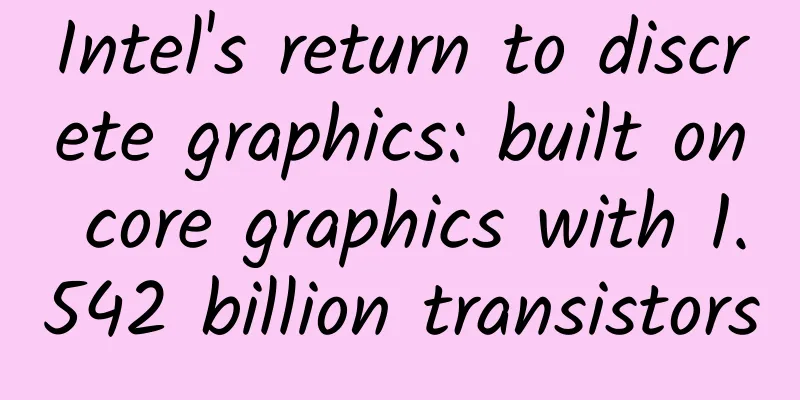Intel's return to discrete graphics: built on core graphics with 1.542 billion transistors

|
Intel occupies most of the world's graphics card market, but they are all based on their own integrated core graphics cards, which are barely usable. Historically, Intel has had two experiences with discrete graphics cards. The first was the 740 in 1998, the only discrete graphics card ever launched by Intel. The second was the Larrabee project from 2008 to 2010, which attempted to build an x86 architecture graphics card. However, it failed and the Xeon Phi accelerator project was successful.
Recently, Intel poached Raja Koduri, head of AMD's graphics card business, and appointed him as chief architect and senior vice president of the Core and Visual Computing Division. Its ambition to return to the independent graphics card market is obvious. At the ISSCC 2018 International Solid-State Circuits Conference held in San Francisco recently, Intel publicly disclosed for the first time the design ideas and prototypes of the new generation of independent graphics cards. Although they are only used for technical research and conceptual purposes, they can be regarded as an official announcement of the return of independent graphics cards. Intel did not provide any physical products this time, but only said that it has developed a GPU prototype chip and introduced some simple architecture and specifications. This GPU prototype chip is manufactured using Intel's 14nm process, has an area of 8×8 mm, and integrates 1.524 billion transistors. The architecture is based on Intel's current ninth-generation core graphics, but it is a low-voltage version Gen9LP on an ultra-low power platform. The basic internal structure is still EU computing units, totaling 18, divided into three groups, while integrating the system assistant (System Agent), including control system, IO, and even 4MB page cache. They are connected to the PC host through an FPGA bridge module and then through the PCI-E bus. As for future plans for discrete graphics cards, Intel will certainly not reveal anything, but AMD and NVIDIA have enough reasons to be highly alert.
As a winner of Toutiao's Qingyun Plan and Baijiahao's Bai+ Plan, the 2019 Baidu Digital Author of the Year, the Baijiahao's Most Popular Author in the Technology Field, the 2019 Sogou Technology and Culture Author, and the 2021 Baijiahao Quarterly Influential Creator, he has won many awards, including the 2013 Sohu Best Industry Media Person, the 2015 China New Media Entrepreneurship Competition Beijing Third Place, the 2015 Guangmang Experience Award, the 2015 China New Media Entrepreneurship Competition Finals Third Place, and the 2018 Baidu Dynamic Annual Powerful Celebrity. |
<<: iPhone 7 "No Service" Issue Can Be Repaired? Wishful Thinking
Recommend
Teach you step by step how to create popular internet celebrity food
For us now, eating is no longer a simple matter o...
At a time when copycat variety shows are becoming popular, let's see how "The Amazing Race 3" can redeem the reputation of copyrighted variety shows
Recently, with the launch of new seasons of progr...
A good article to solve your doubts: HD multi-screen adaptation solution for mobile H5 pages
Visual Mockup Before front-end development, the v...
Marketing promotion: How are brainwashing advertisements made?
The main reason why brainwashing advertisements c...
Attention! These 6 foods are highly toxic. Don’t keep them, let alone eat them! Throw them away immediately!
In life, many foods are delicious when they are n...
OpenAI officially released: ChatGPT "Classroom Teaching" Usage Guide
In February this year, the University of Hong Kon...
After the age of 50, eating more carbohydrates can reduce mortality! A special reminder: Don’t eat with a spoon…
This article was reviewed by Zhang Zhaomin, Maste...
Detail page copywriting template with conversion rate over 85%!
Copywriting has always been a very popular job : ...
Cash loan product operation routines and operation system construction!
Recently, I was tasked to study the product opera...
Japan develops microrobots: DNA controls movement like cells
Living things are the most inspiring, but also di...
Do you know the complete guide to planning Double Eleven e-commerce events in 2019?
What are you planning to buy on Double Eleven? Wh...
How to play with Tik Tok splash screen ads? Here’s a set of “Douyin” marketing techniques for you!
There is no doubt that TikTok has become a social...
When learning to cook, the beasts are not afraid of burning the bottom of the pot, but are afraid of scalding themselves! Get these first aid skills
Starting from September this year, the Ministry o...



![[Creative Cultivation Program] Why does the promised rainstorm never come?](/upload/images/67f260ae74952.webp)





